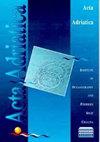The occurrence of the jellyfish Aequorea cf. forskalea in the Adriatic Sea
IF 0.6
4区 生物学
Q3 MARINE & FRESHWATER BIOLOGY
引用次数: 0
Abstract
Jellyfish are becoming an increasingly important component of studies of the global marine environment, as their frequent mass phenomena affect ecosystem performance and have economic and health consequences. Recent research has focused primarily on mass occurrences of scyphozoans and ctenophores, while less attention has been paid to hydromedusae blooms, which can also have significant impacts on the marine ecosystem with economic consequences. Like many members of the Scyphozoa and Ctenophora, Aequorea species can be numerous and form blooms. Based on surveys from 2000 to 2020 and information provided by marine professionals, we examine the (multiannual) variability, seasonality, and spatial distribution patterns of the poorly studied temperate species Aequorea cf. forskalea (Hydrozoa: Leptothecata). We hypothesized that this macrogelatinous jellyfish with a bipartite life cycle (benthic polyps and planktonic medusae) is sensitive to seasonal and long-term temperature fluctuations, particularly because temperature has been shown to play a critical role in mediating transitions in the life cycle of cnidarians. The cold-water affinity of A. cf. forskalea was confirmed by a significant negative correlation with temperature and the most frequent occurrence during the winter-spring period. For the northern Adriatic (Gulf of Trieste), sea temperature data and semi-quantitative plankton data are available for the first decade of the 20th century, allowing comparison of the historical data (1900-1911) with our current data set. Compared to historical records, the current occurrence of A. cf. forskalea differs significantly. With the warming of the northern Adriatic Sea since the beginning of the 20th century, the current phenology of A. cf. forskalea has changed, probably related to the delayed production of medusae by hydroids in autumn, the absence of medusae in this season and their less frequent occurrence in winter.水母Aequorea cf.forskalea在亚得里亚海的出现
水母正成为全球海洋环境研究中越来越重要的组成部分,因为它们频繁的群体现象影响生态系统的性能,并产生经济和健康后果。最近的研究主要集中在大规模发生的镰刀形目和栉水母上,而对水华的关注较少,水华也会对海洋生态系统产生重大影响,并产生经济后果。像许多Scyphozoa和Ctenophora的成员一样,Aequorea物种可以数量众多并形成花朵。根据2000年至2020年的调查和海洋专业人员提供的信息,我们研究了研究不足的温带物种Aequorea cf.forskalea(Hydrozoa:Leptotecata)的(多年)变化、季节性和空间分布模式。我们假设这种具有二分生命周期的大型凝胶水母(海底息肉和浮游水母)对季节性和长期的温度波动敏感,特别是因为温度已被证明在介导线虫生命周期的转变中发挥着关键作用。forskalea的冷水亲和力与温度呈显著负相关,且在冬春季节最为频繁。对于亚得里亚海北部(的里雅斯特湾),有20世纪前十年的海水温度数据和半定量浮游生物数据,可以将历史数据(1900-1911)与我们当前的数据集进行比较。与历史记录相比,福斯卡拉A.cf.目前的发生情况有很大不同。自20世纪初以来,随着亚得里亚海北部的变暖,目前的A.cf.forskalea的酚学发生了变化,这可能与秋季水生生物延迟产生水母、这个季节没有水母以及冬季水母不太频繁有关。
本文章由计算机程序翻译,如有差异,请以英文原文为准。
求助全文
约1分钟内获得全文
求助全文
来源期刊

Acta Adriatica
生物-海洋与淡水生物学
CiteScore
1.60
自引率
11.10%
发文量
13
审稿时长
>12 weeks
期刊介绍:
Journal "Acta Adriatica" is an Open Access journal. Users are allowed to read, download, copy, redistribute, print, search and link to material, and alter, transform, or build upon the material, or use them for any other lawful purpose as long as they attribute the source in an appropriate manner according to the CC BY licence.
 求助内容:
求助内容: 应助结果提醒方式:
应助结果提醒方式:


